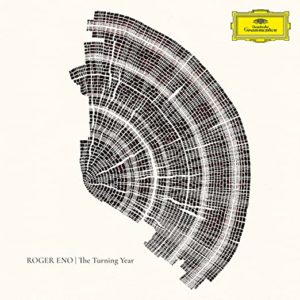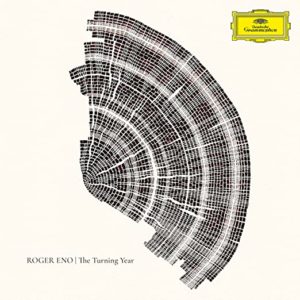Aus der Erinnerung fallen mir eine gute Handvoll Alben ein, neben die ich „The Turning Year“ in einem Regal einordnen könnte – wobei sich das Werk selber schlichtem Rubrizieren entzieht. Die besten Ordnungssysteme sind bekanntlich die, welche nach allen Himmelsrichtungen offen sind. In diesem Sinne lege ich nur ein paar Fährten der Abteilung „Hinterlandmusik“ (nicht „Hintergrundmusik“!) aus: Herbert Hencks „Musica Callada“, seine Interpretation von Stücken von Federico Mompou. Glauco Veniers „Miniature Music“ (subtitled „Music for Piano and Percussion – is there a more unknown ECM-album?). Dann Nils Frahms „All Melody“ (diese Produktion entstand, reiner Zufall, auch in Berlin). Steve Tibbetts’ „Northern Song“. Erik Honoré’s „Heliographs“. Misha Alperins „At Home“. „Mixing Colours“ sowieso (the interview with „The Elderly Brothers“, in regards to their DGG-release in „Electronic Sound“, is good-humoured and insightful). Cluster‘s „Sowiesoso“ (aufgenommen 1976 in Forst und gemischt in Connys Studio). Group Listening: Clarinet & Piano – Selected Works, Vol. 2 („imagine a missing link between „Obscure Records and ECM‘s New Series“). Will Burns & Hannah Peel: Chalk Hill Blue. Roberto Musci‘s „Tower of Silence“. Sigurd Holes „Roraima“. Hans Ottes „Buch der Klänge“ (wiederum dargeboten von Herbert Henck). Und „The Equatorial Stars“ von Fripp & Eno.
Es kommt vor, dass Phänomene, die sich am Rande, fast schemenhaft, bewegen, einen ebenso tiefgreifenden Einfluss auf das innere Erleben ausüben wie das, was im Brennglas konzentrierter Aufmerksamkeit funkelt. Nicht zuletzt in dieser Hinsicht ist „The Turning Year“ ein kleines, frei schwebendes Meisterstück, das leicht unterschätzt werden kann. Nichts ist so langweilig wie eine Notation, die keine Fragen offenlässt. Die meisten Alben von Roger Eno kenne ich seit seinem ersten Auftauchen auf einem Meilenstein aus den „goldenen Jahren der Ambient Music“ (Apollo) ziemlich gut. Bevor das Wort „neoklassisch“ zur Schublade der Popkultur wurde für introspektive Erkundungen, zwischen klassisch geschultem Ohr und autodidaktischer Aneignung, setzte Rogers Soloalbum „Voices“ (aus Bob und Dan Lanois‘ Grant Avenue Studios in Hamilton, Ontario) die berüchtigte Messlatte hoch für eine Musik, die nicht nach Aufmerksamkeit giert, und uns Ohrensesselreisende in ein kontemplatives, a l p h a w e l l e n f r e u d i g e s Stimmungsfeld versetzt.
„Modern Mood Music“, so betitelte Richard Williams einst im Melody Maker eine Besprechung der Schallplatten „Places“ von Jan Garbarek, „Mr. Gone“ von Weather Report, und „Music For Films“ von Brian Eno.) Oft genug gelangen dem Mann aus Woodbridge (in den Jahren und Arbeiten nach „Voices“) delikate Gleichgewichte zwischen Oberflächenreiz und Tiefenwirksamkeit. Die Konstante: ein dunkles Leuchten, die Bandbreite erstaunlich, zwischen Kammerspiel und Kunstlied, Improvisation und Ambient. Highlights wie „Voices“ (das Album bescherte ihm einen kleinen Geldsegen, weil es dem „Erotik-Thrill“ des Kinofilms „9 1/2 Wochen“ ein paar Atempausen bescherte), „Between Tides“, „The Flatlands“, „Lost In Transition“, „Swimming“ und – Soundaskese pur – „The Floating World“. Alle Süßholzraspelei meilenweit entfernt. Verdammt ernste Musik mit einem beinahe kindlichen Gespür für das Staunen. Rogers Samtpfotenpiano, die Verwehungen des Streicherensembles Scoring Berlin, Tibor Remans Klarinette („On The Horizon“) – die Besetzungsliste wäre unvollständig ohne einen gewissen Mr. „In-Between“, ohne den unbestimmten Raum (Zonen namens Aura, Nachklang, Stille).
Im Gegensatz zu dem über lange Zeiten fast nomadischen Leben seines Bruders Brian liess es Roger von früh an ruhig angehen, und verliess nur sporadisch die Räume seiner Kindheit in East Anglia. Dieses neue, allerfeinste Opus beginnt mit „A Place We Once Walked“ – wäre der Begriff „Heimatmusik“ bloss nicht so gruselig konnotiert, hier könnte er vor Anker gehen! Manche dieser pastoralen Szenerien (gutes altes Cinemascope) erfordern einen double take: Spuren des Unheimlichen, die sich hinter dem Schimmer, dem „Anheimelnden“, verbergen! Übrigens, wenn man das Klappcover der Schallplatte öffnet, findet sich eine Reihe von kleinen Fotos aus Rogers Archiv, eine dezente Anreicherung all dieser wunderlichen Melancholien einer als Musik getarnten Tranceinduktion erster Güte.

